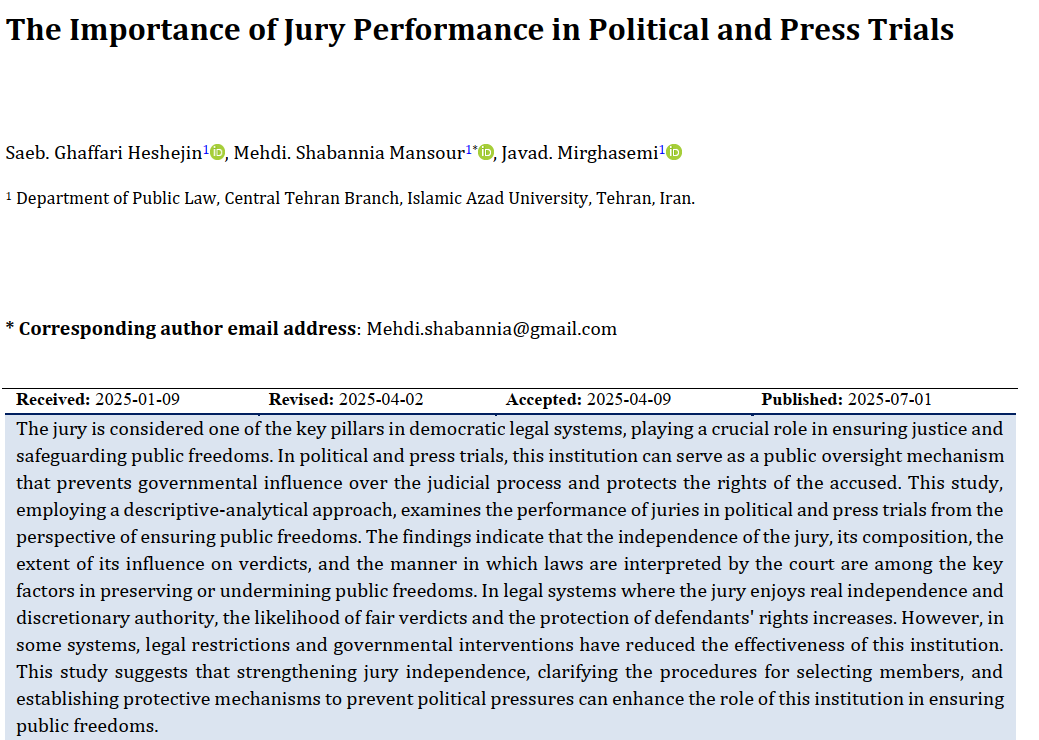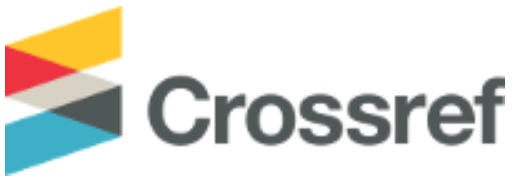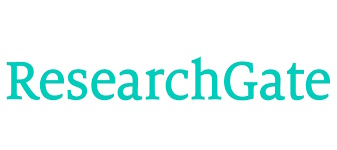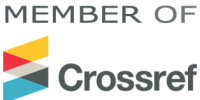The Importance of Jury Performance in Political and Press Trials
Keywords:
Jury, political trials, press trials, public freedoms, justice, judicial independence, defendants' rightsAbstract
The jury is considered one of the key pillars in democratic legal systems, playing a crucial role in ensuring justice and safeguarding public freedoms. In political and press trials, this institution can serve as a public oversight mechanism that prevents governmental influence over the judicial process and protects the rights of the accused. This study, employing a descriptive-analytical approach, examines the performance of juries in political and press trials from the perspective of ensuring public freedoms. The findings indicate that the independence of the jury, its composition, the extent of its influence on verdicts, and the manner in which laws are interpreted by the court are among the key factors in preserving or undermining public freedoms. In legal systems where the jury enjoys real independence and discretionary authority, the likelihood of fair verdicts and the protection of defendants' rights increases. However, in some systems, legal restrictions and governmental interventions have reduced the effectiveness of this institution. This study suggests that strengthening jury independence, clarifying the procedures for selecting members, and establishing protective mechanisms to prevent political pressures can enhance the role of this institution in ensuring public freedoms.
Downloads
References
Abercrombie, K. (2019). Writing Women's Experiences: Twelve Memoirs of Life in Iran and Abroad Since the 1940s scholarworks.gsu.edu]. https://scholarworks.gsu.edu/history_theses/125
Ali, M. H., Ahmed, M., Al Karaawi, N. J. M., Algaragolle, W. M. H., Alkhafaji, M., & Abdulaziz, H. M. (2022). The Limitations of Iraq's Freedom of Press and Communicative Media Censorship. International Journal of Criminal Justice Sciences, 17(1), 122-133.
Banai, H. (2020). Hidden Liberalism: Burdened Visions of Progress in Modern Iran. Cambridge University Press. https://doi.org/https://doi.org/10.1017/9781108850445
Böhm, J. (2019). The provocation in art as a political and social act with a focus on Iran search.proquest.com]. https://search.proquest.com/openview/dfbe4f751e4d8de65878cb1f97fbbf2d/1?pq-origsite=gscholar%5C&cbl=2026366%5C&diss=y
Bourdon, K., & Meyer, D. S. (2023). Contentious politics. books.google.com. https://doi.org/https://doi.org/10.4337/9781803921235.00033
Chaudhuri, S. (2022). Crisis cinema in the Middle East: Creativity and constraint in Iran and the Arab world. Bloomsbury Publishing. https://doi.org/https://doi.org/10.5040/9781350190542
Eslami, T., Khadrbagli, S., & Maleki, M. B. (2024). A Study on the Right to Freedom of thought and Expression and Its Criminal Limitations Under Iranian Law. kbr.vsbm.sk. https://kbr.vsbm.sk/2024/n2/eslami_khadrbagli_badali-maleki.pdf
Feldman, O. (2024). Communicating political humor in the media: How culture influences satire and irony. books.google.com. https://doi.org/https://doi.org/10.1007/978-981-97-0726-3
Hill, S., & Garner, R. P. (2021). Virtue signalling and the Condorcet Jury theorem. Synthese, 199(5-6), 14821-14841. https://doi.org/https://doi.org/10.1007/s11229-021-03444-6
Konde, F. (2024). Visual Activism, Censorship, and Political Dissent: A Study of Jafar Panahi's Work in the Iranian Context dspace.unive.it]. http://dspace.unive.it/handle/10579/26542
Liu, J. Z., & Chen, L. (2020). Jury trial and public trust in the judiciary: evidence from cross-countries comparison. Asia Pacific Law Review, 28(2), 412-436. https://doi.org/https://doi.org/10.1080/10192557.2020.1867794
McDaniel, T. (2018). Autocracy, Modernization, and Revolution in Russia and Iran. https://doi.org/https://doi.org/10.2307/j.ctt7zvhn6
Pourrashidi, H., Alipoor, J., Samadi, M., & Soleimani, N. (2022). Understanding Islamic Republic of Iran's Media Policy: A Concentration on Regulations and Laws. Southern Communication Journal, 87(1), 97-107. https://doi.org/https://doi.org/10.1080/1041794X.2021.2011955
Rasooli, S. (2021). Characteristics of MEK's narrative on twitter in reflection to Iran protests in November 2019: A hermeneutical analysis of mash-up videos on twitter. https://ddd.uab.cat/record/251981
Sefat, F. M. M. (2016). Political Economy of Iran: Institutions versus Culture etheses.whiterose.ac.uk]. https://scholar.google.com/scholar?q=Political+Economy+of+Iran%3A+Institutions+versus+Culture
Terman, R., & Voeten, E. (2018). The relational politics of shame: Evidence from the universal periodic review. Review of International Organizations, 13(1), 1-23. https://doi.org/https://doi.org/10.1007/s11558-016-9264-x

Downloads
Additional Files
Published
Submitted
Revised
Accepted
Issue
Section
License
Copyright (c) 2025 Saeb Ghaffari Heshejin, Mehdi Shabannia Mansour, Javad Mirghasemi (Author)

This work is licensed under a Creative Commons Attribution-NonCommercial 4.0 International License.





